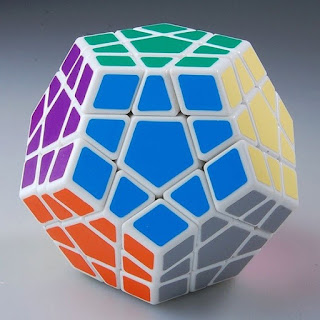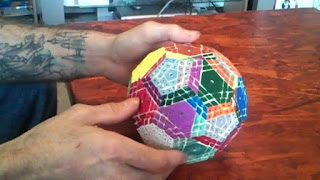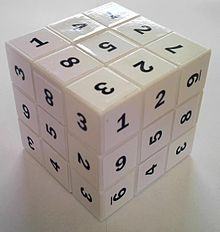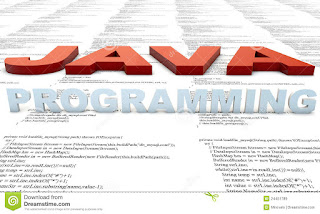Do you think a Rubik’s cube is the most complicated mechanical puzzle ever invented? You have no idea how complicated mechanical puzzles can be.
A Standard 3x3x3 Rubik’s cube can have 43,252,003,274,489,856,000 combinations, but only 1 solution.
To put this into perspective, if we have one Rubik’s cube for each possible combination, then all the cubes will cover the whole surface of 275 earth-sized planets. and among all of them, only 1 cube will be in perfectly solved state.
But for some people, this was not complicated enough. they created 4x4x4 cubes, and also 5x5x5 cubes.
A 4x4x4 cube has 7401196841564901869874093974498574336000000000 combinations. If you have that many teaspoons of sugar, it will fill a sphere the size of the solar system 3.5 times over.
a 5x5x5 Rubik’s cube has 282870942277741856536180333107150328293127731985672134721536000000000000000 combinations, this is close to number of atoms in the known universe. and yet, people can solve it within few minutes.
So, some people though it was not complicated enough, they created this monster:
Say hello to 11x11x11 cube.
Is it world’s most complicated cube? Nope. The largest cube ever made is 17x17x17. Having a total combination of 66.9 * 10^1053. This number is so huge it’s digits can not even be written in here.
Yet, someone solved this thing in 7.5 hours. (reference link below).
Are Rubik’s cubes are the most complicated puzzle ever? Nope! Lets meet Minxes.
Minxes are like Rubik’s cube, but with more than 6 sides. Having more sides also makes them more complicated.
This is a 3x3x3 Megaminx. It has 12 faces and total 50 moving parts, whereas the Rubik’s cube has only 6 faces and 20 moving parts.
A 3x3x3 megaminx has 100669616553523347122516032313645505168688116411019768627200000000000 combinations, i.e. 1000 billion billion (yes there are two billions) more times than a 4x4x4 rubics cube.
The world record for fastest megaminx solving is 37.58 seconds.
Still not complex enough? meet the Gigaminx, with a 5x5x5 structure, the Teraminx with 7x7x7 structure and the Examinx, with 9x9x9 structure.
And this is how it looks when scrambled.
The combinations possible with a Examinx is not worth calculating…
But wait.
Someone has made a Yotaminx, a minx with 15x15x15 structure.
Not sure if anyone was able to solve it or not.
And for people with nerve of steel, here is a Tuttaminx (Thanks Shrey Gadiya for the reference) with 32 faces and 150 movable parts.
If you scramble this, it looks like this
After seeing all these, if you think a puzzle can not be more complicated than a Tuttaminx, you are wrong!
Multiple Minxes can be fused together to form a combined minx. Here is a triple fused Petaminx
These puzzles have no practical use for mortals. Although in Hell, they may ask you to solve one.
Update: as mentioned by Digvijay Pr , there are Shape shifting puzzles with non-linear movements as well, like the Ghost cube.
This is how it looks when scrambled, Goodbye brain
Due to each piece being of a different shape, this puzzle is notoriously difficult to solve. Unlike a Rubik’s cube the movements of the pieces are restricted due to their shape, so it’s very difficult to mathematically calculate the number of possible moves with this one.
Update 2: If your brain is still not fried, let’s meet Sudoku cube, as suggested by Gourab Chowdhury.
The Sudoku Cube or is a variation on a Rubik's Cube in which the faces have numbers one to nine on the sides instead of colours. The aim is to solve Sudoku puzzles on one or more of the sides.
In the Sudoku Cube, the player must place the numbers one to nine on each side with no repetition.
This cube is one of the most difficult of all the cubes, because as well as having to know the basic cubes concepts you also have to know basic sudoku concepts, and unlike normal sudoku any turn of the cube can wipe out work you just did.
What makes this more complicated than a normal Rubik’s cube is unlike a normal colored Rubik’s cube, there is no way to identify which piece originally belonged to which side !!!
Look how confusing a Sudoku cube can make you when it is scrambled. Not only you have no idea to which side the numbers actually belong, but they are also tilted, rotated and can become completely upside down.
So, this must be the most complicated puzzle right? because it has the combined evil nature of both Rubik’s cube and Sudoku…
I also thought so, until I saw this guy… which has 81 numbers each side compared to just 9 of a regular Sudoku cube
R.I.P brain :-(
Update 3: Some friends have asked how to calculate the total number of combinations possible with a cube. Here is the mathematical formula as taken from Welcome to speedcubing.com! [see reference 3]. In the below formula, n is the number of pieces each side. for a 3x3x3 cube, n = 3
Thanks for reading don't forget to follow.
A Standard 3x3x3 Rubik’s cube can have 43,252,003,274,489,856,000 combinations, but only 1 solution.
To put this into perspective, if we have one Rubik’s cube for each possible combination, then all the cubes will cover the whole surface of 275 earth-sized planets. and among all of them, only 1 cube will be in perfectly solved state.
But for some people, this was not complicated enough. they created 4x4x4 cubes, and also 5x5x5 cubes.
A 4x4x4 cube has 7401196841564901869874093974498574336000000000 combinations. If you have that many teaspoons of sugar, it will fill a sphere the size of the solar system 3.5 times over.
a 5x5x5 Rubik’s cube has 282870942277741856536180333107150328293127731985672134721536000000000000000 combinations, this is close to number of atoms in the known universe. and yet, people can solve it within few minutes.
So, some people though it was not complicated enough, they created this monster:
Say hello to 11x11x11 cube.
Is it world’s most complicated cube? Nope. The largest cube ever made is 17x17x17. Having a total combination of 66.9 * 10^1053. This number is so huge it’s digits can not even be written in here.
Yet, someone solved this thing in 7.5 hours. (reference link below).
Are Rubik’s cubes are the most complicated puzzle ever? Nope! Lets meet Minxes.
Minxes are like Rubik’s cube, but with more than 6 sides. Having more sides also makes them more complicated.
This is a 3x3x3 Megaminx. It has 12 faces and total 50 moving parts, whereas the Rubik’s cube has only 6 faces and 20 moving parts.
A 3x3x3 megaminx has 100669616553523347122516032313645505168688116411019768627200000000000 combinations, i.e. 1000 billion billion (yes there are two billions) more times than a 4x4x4 rubics cube.
The world record for fastest megaminx solving is 37.58 seconds.
Still not complex enough? meet the Gigaminx, with a 5x5x5 structure, the Teraminx with 7x7x7 structure and the Examinx, with 9x9x9 structure.
And this is how it looks when scrambled.
The combinations possible with a Examinx is not worth calculating…
But wait.
Someone has made a Yotaminx, a minx with 15x15x15 structure.
Not sure if anyone was able to solve it or not.
And for people with nerve of steel, here is a Tuttaminx (Thanks Shrey Gadiya for the reference) with 32 faces and 150 movable parts.
If you scramble this, it looks like this
After seeing all these, if you think a puzzle can not be more complicated than a Tuttaminx, you are wrong!
Multiple Minxes can be fused together to form a combined minx. Here is a triple fused Petaminx
These puzzles have no practical use for mortals. Although in Hell, they may ask you to solve one.
Update: as mentioned by Digvijay Pr , there are Shape shifting puzzles with non-linear movements as well, like the Ghost cube.
This is how it looks when scrambled, Goodbye brain
Due to each piece being of a different shape, this puzzle is notoriously difficult to solve. Unlike a Rubik’s cube the movements of the pieces are restricted due to their shape, so it’s very difficult to mathematically calculate the number of possible moves with this one.
Update 2: If your brain is still not fried, let’s meet Sudoku cube, as suggested by Gourab Chowdhury.
The Sudoku Cube or is a variation on a Rubik's Cube in which the faces have numbers one to nine on the sides instead of colours. The aim is to solve Sudoku puzzles on one or more of the sides.
In the Sudoku Cube, the player must place the numbers one to nine on each side with no repetition.
This cube is one of the most difficult of all the cubes, because as well as having to know the basic cubes concepts you also have to know basic sudoku concepts, and unlike normal sudoku any turn of the cube can wipe out work you just did.
What makes this more complicated than a normal Rubik’s cube is unlike a normal colored Rubik’s cube, there is no way to identify which piece originally belonged to which side !!!
Look how confusing a Sudoku cube can make you when it is scrambled. Not only you have no idea to which side the numbers actually belong, but they are also tilted, rotated and can become completely upside down.
So, this must be the most complicated puzzle right? because it has the combined evil nature of both Rubik’s cube and Sudoku…
I also thought so, until I saw this guy… which has 81 numbers each side compared to just 9 of a regular Sudoku cube
R.I.P brain :-(
Update 3: Some friends have asked how to calculate the total number of combinations possible with a cube. Here is the mathematical formula as taken from Welcome to speedcubing.com! [see reference 3]. In the below formula, n is the number of pieces each side. for a 3x3x3 cube, n = 3
Thanks for reading don't forget to follow.



















